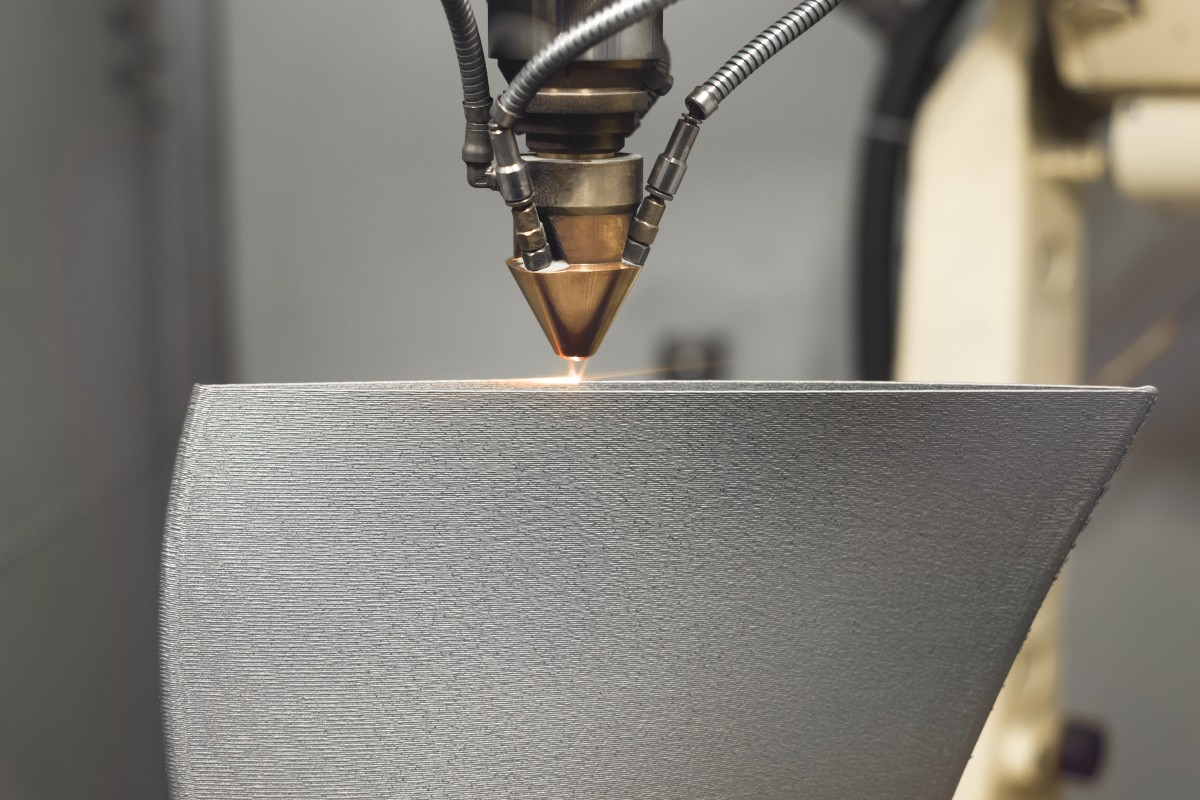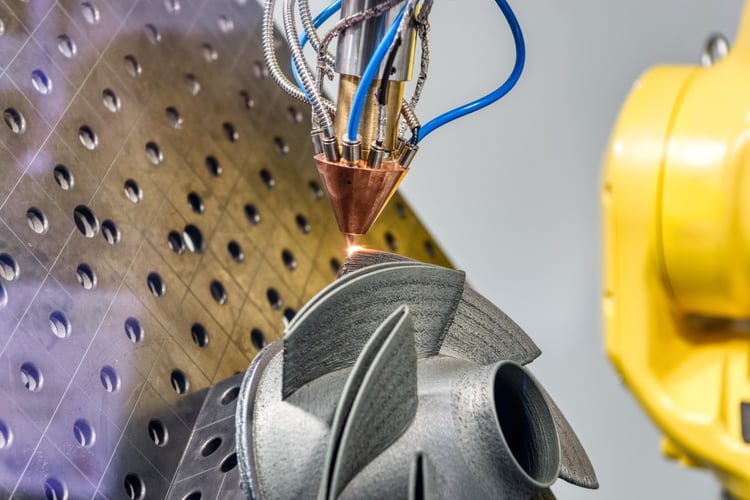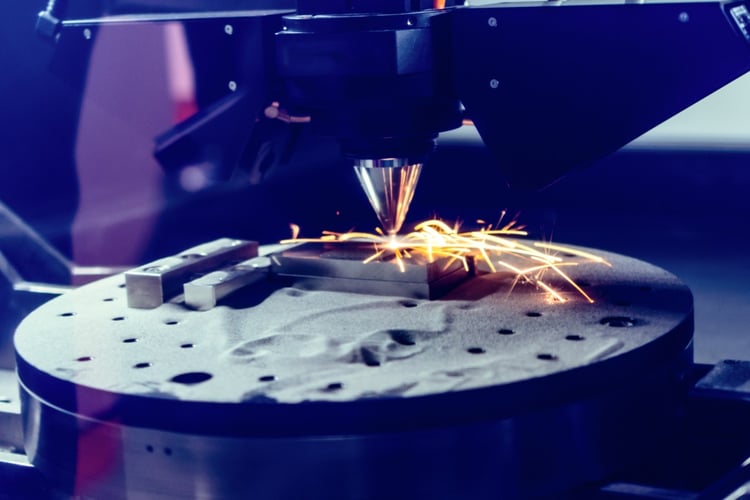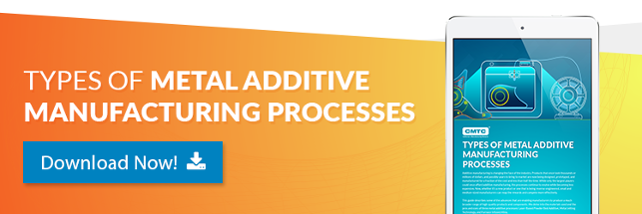May 7, 2021 | Additive Manufacturing
Metal Additive Manufacturing: What You Need to Know

Additive manufacturing has transformed the manufacturing industry since its commercial inception in the late 20th century. As additive processes continue to take the industry by storm, Metal AM and numerous applications of the process are moving to the forefront of manufacturing for production.
Buoyed by the release of new Metal AM machines with open material platforms and faster printing speeds, sales of Metal AM systems are burgeoning with the segment expected to create an almost 4 billion revenue opportunity by 2024. As advancements in metal additive manufacturing continue, it’s important to be aware of the benefits of Metal AM and how the numerous applications of the process are changing the face of manufacturing.
Quick Links:
- History Of Metal Additive Manufacturing
- Metal Additive Manufacturing/ 3D Printing Processes
- Metal Additive Manufacturing Techniques
- Advantages Of Metal AM Technology
- Take Advantage Of Additive Manufacturing In Your California Facility With CMTC
History of Metal Additive Manufacturing
The additive manufacturing process can trace its roots to the mid-1980s as methods of faster product development were being introduced. Originally called rapid prototyping, this process was capable of producing dimensional models to create faster prototypes to test the fit and function of the model.
By 1987, a new plastic processing technique known as Stereolithography (SLA) became commercialized, becoming the first patent in additive manufacturing. With SLA, manufacturers could solidify UV light-sensitive liquid polymers with a laser, producing 3-D models faster than ever before. This milestone in additive processes offered manufacturers, engineers, and designers new opportunities for creating products more efficiently than previously.
By the early 1990s, other polymer-based additive manufacturing processes became commercially available. In 1992, Selective Laser Sintering (SLS), which fuses powder materials into a solid using a laser, became available. Not long after, metal additive manufacturing was patented and available to the market. Like other additive manufacturing processes, this technology enabled the rapid production of metal prototypes, products, and tools. While the introduction of metal additive manufacturing processes enabled the manufacturing of metal parts by sintering the metal powder of choice, the end result was materials more comparable to composites rather than alloys since materials with low melting points could be now combined with high resistance metals, such as stainless steel.
Metal Additive Manufacturing & 3D Printing Processes
The additive manufacturing process creates objects by adding material layer by layer whether metal, plastic, or ceramics. Additive manufacturing can augment, and in some cases, replace traditional methods of creating objects through machining, cutting, turning, shaping, milling, and other “subtractive” manufacturing processes.
To make an object using additive manufacturing, a design is created using CAD (Computer-Aided Design) software or by taking a scan of the object that will be printed. The software can translate the scan into a precise framework for the 3D printing machine to follow layer by layer.
Metal additive manufacturing, also known as metal 3D printing, takes the additive manufacturing process and applies it to exclusively metals. By layering metal powders, either with an energy source or a binding agent, precise objects can be designed and constructed. Due to the advancements in additive manufacturing machines, objects that could never have been created even a few years ago can now be manufactured with new strength and standards using a variety of materials.
The wide range of metal powders available for additive manufacturing techniques is constantly expanding. Some of the most common metal materials include stainless steel grades, nickel, cobalt-chrome, titanium alloys, and aluminum. This ever-increasing range of building materials allows for the manufacturer to choose the right material for the exact specifications and expectations of the object.

Metal Additive Manufacturing Techniques
Metal additive manufacturing methods can be classified into what process is used to join the metal, which includes a binder, heated nozzle, or lasers. Below are some of the most common metal additive manufacturing techniques. Depending on the technique employed, the resulting printed part may be net-shape or near-net shape.
Laser-Based Powder Bed Additive
Powder bed fusion (PBF) methods employ the use of either a laser or electron beam to melt and fuse the metal powder into a solid. This technique includes the following metal additive manufacturing methods: Electron beam melting (EBM), direct metal laser sintering (DMLS), selective heat sintering (SHS), and selective laser melting (SLM). Selective laser sintering (SLS) is an additional technique that uses a laser as the power source to sinter powdered materials, although polymers, rather than metals, are commonly used in SLS.
Regardless of the method, all laser-based powder bed techniques require the spreading of the metal powder over previous layers, whether through a roller or blade. The most commonly employed metals in this additive process are stainless steel, titanium, aluminum, steel, and cobalt chrome, and copper.
Metal Binder Jetting
This metal additive manufacturing method is similar to that of a two-dimensional ink jet printer. Metal powders are jetted onto a build platform to print objects using either a continuous or drop on demand (DOD) approach. A liquid binder is applied to combine the powder layer by layer, building the desired object. Parts just printed are initially fragile and require post-processing sintering and infiltration to be strengthened. The end-result can go through an optional finishing process where the part is either polished or plated with nickel or gold.
One of the unique benefits of binder jetting is the elimination of any melting of metal powders, which can lead to residual stresses building up. It’s also one of the least expensive metal additive manufacturing techniques.
Sheet Lamination
This method joins sheets of material together layer by layer through bonding, ultrasonic welding, or brazing to build an object. Sheet lamination methods are low-temperature processes and can bond different materials together. Typically, sheet lamination methods are for visual and aesthetic models rather than for structural use.
Directed Energy Deposition
A more complex 3D printing process, this method operates as its name suggests — a focused energy source, such as a laser or electron beam, is directed at the building material to melt it while it is simultaneously being deposited layer by layer. This technique is commonly used to repair or to add additional material to existing structures. Directed Energy Deposition (DED) uses a heated nozzle to deposit melted material - typically either titanium or cobalt chrome - onto the specified surface where it solidifies.

Advantages of Metal AM Technology
In the last few decades of its existence, additive manufacturing technologies have had a revolutionary impact on the manufacturing sector as a whole. This ability to coalesce assemblies - printing a part as a single unit instead of multiple parts that must be joined or fastened - reduces material waste and typically improves the product’s overall quality and performance. Besides this waste-saving advantage, metal AM methods offer unique benefits which include:
Complexity is “Free”
When using traditional subtractive manufacturing processes, increased complexity in a part’s design results in increasingly higher cost as more and more subtractive milling, contouring, and finishing operations are necessary. When using Additive, the complexity of a design adds little cost and often reduces the cost of the part. For example, if the part is a prismatic part - a solid rectangular block - milling from near-net shape billet is simple and requires few passes on the mill and therefore low cost. Printing block using Additive would require many passes on the machine to deposit the required amount of material to build up the shape resulting in a much higher cost. However, if the part is an organic shape - think of a brace that looks like a tree root structure - milling will likely require custom holding fixtures and many machine passes, often with multiple tool changes, and extensive tool path coding all leading to high cost. To print the organic shape with Additive, the tool path is created automatically using software and the number of passes and amount of material deposited is greatly reduced resulting in a lower cost for this part.
Eliminating Extra Costs
Metal additive processes reduce material waste compared to traditional methods. Since the raw material is precisely built layer by layer, there is little need to subtract or shave off pieces off of the solid object. Only the material that is needed is used and placed exactly where it is needed, making metal AM technologies resource-efficient.
Additionally, metal additive manufacturing reduces waste by eliminating the need for expensive tooling, saving your business money and time. By choosing the right metal additive manufacturing process, you can access a wide variety of materials to meet your specific production needs.
A Wide Range of Materials
A material's properties and overall performance are determined by its chemical composition, crystalline state, and underlying micro-architecture. These characteristics force engineers to accept certain trade-offs when choosing a material for a specific application. However, this concession may soon be a thing of the past due to advancements in 3D printing technology.
Whereas before manufacturers were limited to the materials used in metal AM, there is an increasingly greater variety of metal powders able to be used. Some of the more common metal materials available include:
- Stainless steel
- Steel
- Titanium
- Aluminum
- Copper
- Cobalt Chrome
- Titanium alloys
- Nickel Alloys
- Gold
- Silver
- Platinum
- Palladium
As advancements in additive manufacturing are made, the list of metal powders capable of being used will continue to expand.
Improved Design Abilities & Topology Optimization
With metal additive manufacturing, unique and complex structures can be created that otherwise would have taken additional time and parts. By coalescing assemblies, objects can now be produced as a single unit for greater strength and efficiency instead of multiple parts that must be joined or fastened post-production.
Additionally, recent advances in automated design have enabled the production of products for a wealth of applications. Topology Optimization software allows designers to specify the parameters of a part and allow the software to define its architecture based on desired structural, functional, thermal, or other properties. The end-results are designs that can be made stronger, lighter, tougher, and more resistant to natural forces and external conditions.
Reduction in Production Time
One of the well-known advantages of metal additive manufacturing is the reduction of the time it takes for products to transition from the design stage to final production when compared to traditional machining. Since there’s little need for specific machining and tools to process the object after being 3D printed, the metal AM can create parts within days instead of weeks.
Take Advantage of Additive Manufacturing in Your California Facility With CMTC
Does metal additive manufacturing sound like a technology that could be harnessed by your manufacturing business? Like any new technology, there’s always a bit of a learning curve. That’s why in our guide Types of Metal Additive Manufacturing Processes, we delve into the inner-workings of all the above-mentioned processes, the materials used, and the pros and cons of each.
Stay in the know and keep up with others in the industry by downloading the free guide today. In the meantime, if you have any additional questions about additive manufacturing, please reach out to the experts at CMTC. We’re here and happy to help!
About the Author
Gregg Profozich
Gregg Profozich is a manufacturing, operations and technology executive who believes that manufacturing is the key creator of wealth in the economy and that a strong manufacturing sector is critical to our nation’s prosperity and security now, and for future generations. Across his 20-year plus career in manufacturing, operations and technology consulting, Mr. Profozich helped manufacturing companies from the Fortune 500 to the small, independents significantly improve their productivity and competitiveness.

